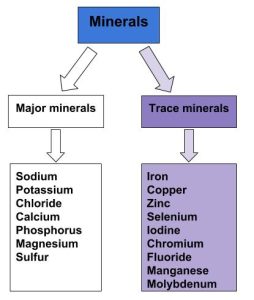University of Hawai‘i at Mānoa Food Science and Human Nutrition Program and Human Nutrition Program
Li‘ili‘i ka ‘ōhiki, loloa ka lua
Small is the crab, large is the hole

Learning Objectives
By the end of this chapter you will be able to:
- Describe the functional role, intake recommendations and sources of trace minerals
Trace minerals are classified as minerals required in the diet each day in smaller amounts, specifically 100 milligrams or less. These include copper, zinc, selenium, iodine, chromium, fluoride, manganese, molybdenum, and others. Although trace minerals are needed in smaller amounts it is important to remember that a deficiency in a trace mineral can be just as detrimental to your health as a major mineral deficiency. Iodine deficiency is a major concern in countries around the world such as Fiji. In the 1990’s, almost 50% of the population had signs of iodine deficiency also known as goiter. To combat this national issue, the government of Fiji banned non-iodized salt and allowed only fortified iodized salt into the country in hopes of increasing the consumption of iodine in people’s diets. With this law, and health promotion efforts encouraging the consumption of seafood, great progress has been made in decreasing the prevalence of iodine deficiency in Fiji.[1]
Figure 11.1 The Trace Minerals

Learning Activities
Technology Note: The second edition of the Human Nutrition Open Educational Resource (OER) textbook features interactive learning activities. These activities are available in the web-based textbook and not available in the downloadable versions (EPUB, Digital PDF, Print_PDF, or Open Document).
Learning activities may be used across various mobile devices, however, for the best user experience it is strongly recommended that users complete these activities using a desktop or laptop computer and in Google Chrome.
- Micronutrient Deficiencies. (2015). Ministry of Health and Medical Services, Shaping Fiji’s Health. http://www.health.gov.fj/?page_id=1406. Accessed November 12, 2017. ↵
An element used in the body to promote chemical reactions and help form body structures.
An essential trace mineral that is involved in the formation of bone and specific reactions of metabolism of amino acids, cholesterol, and carbohydrates.
Trace mineral that acts as a cofactor for several enzymes.
An enlarged thyroid gland caused by a deficiency in iodine.
A small amount of sodium iodide or potassium iodide that is added to table salt in order to supplement the iodine content of the diet.

